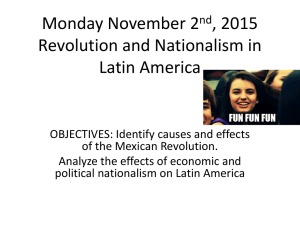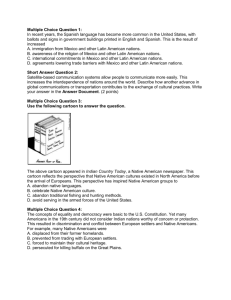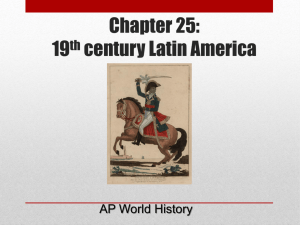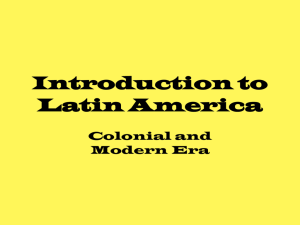Latin American DBQ 1800s
advertisement
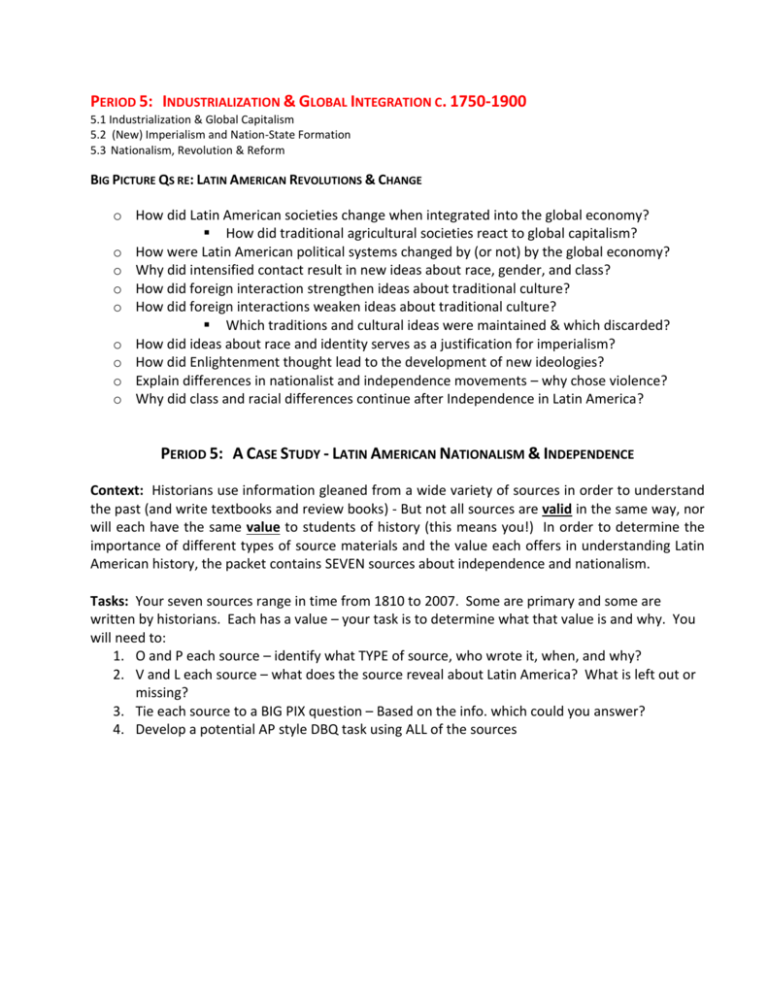
PERIOD 5: INDUSTRIALIZATION & GLOBAL INTEGRATION C. 1750-1900 5.1 Industrialization & Global Capitalism 5.2 (New) Imperialism and Nation-State Formation 5.3 Nationalism, Revolution & Reform BIG PICTURE QS RE: LATIN AMERICAN REVOLUTIONS & CHANGE o How did Latin American societies change when integrated into the global economy? How did traditional agricultural societies react to global capitalism? o How were Latin American political systems changed by (or not) by the global economy? o Why did intensified contact result in new ideas about race, gender, and class? o How did foreign interaction strengthen ideas about traditional culture? o How did foreign interactions weaken ideas about traditional culture? Which traditions and cultural ideas were maintained & which discarded? o How did ideas about race and identity serves as a justification for imperialism? o How did Enlightenment thought lead to the development of new ideologies? o Explain differences in nationalist and independence movements – why chose violence? o Why did class and racial differences continue after Independence in Latin America? PERIOD 5: A CASE STUDY - LATIN AMERICAN NATIONALISM & INDEPENDENCE Context: Historians use information gleaned from a wide variety of sources in order to understand the past (and write textbooks and review books) - But not all sources are valid in the same way, nor will each have the same value to students of history (this means you!) In order to determine the importance of different types of source materials and the value each offers in understanding Latin American history, the packet contains SEVEN sources about independence and nationalism. Tasks: Your seven sources range in time from 1810 to 2007. Some are primary and some are written by historians. Each has a value – your task is to determine what that value is and why. You will need to: 1. O and P each source – identify what TYPE of source, who wrote it, when, and why? 2. V and L each source – what does the source reveal about Latin America? What is left out or missing? 3. Tie each source to a BIG PIX question – Based on the info. which could you answer? 4. Develop a potential AP style DBQ task using ALL of the sources DOCUMENT 1A Source: Approximate wording of the Grito de Dolores (Cry of Dolores) –by Roman Catholic creole priest by Miguel Hidalgo y Costilla in the small town of Dolores, near Guanajuato on September 16, 1810. This has been celebrated as Mexican Independence Day since October 1825 My children: a new dispensation [privilege] comes to us today. Will you receive it? Will you free yourselves? Will you recover the lands stolen three hundred years ago from your forefathers by the hated Spaniards? * We must act at once… Will you defend your religion and your rights as true patriots? Long live our church! Long live our Lady of Guadalupe! Death to bad government! Death to the gachupines! [derogatory or negative reference to penninsulares – referred to spurs they wore ] * In another version, Hidalgo asked the people: Will you be slaves of Napoleon or will you as patriots defend your religion, your hearths and your rights?' DOCUMENT 1B: Source: Grito Mexicano [or the Cry of Patriotism] called each year on eve of Independence Day, September 16th - by the President of the United Mexican States as he rings the bell at the National Palace in Mexico City. (Video Clip http://www.youtube.com/watch?v=sMX7Gd5lSUE) ¡Mexicanos! Long live the heroes that gave us the Fatherland! Long live Hidalgo! Long live Morelos! Long live Josefa Ortiz de Dominguez! Long live Allende! Long live Galena and the Bravos! Long live Aldama and Matamoros! Long live National Independence! ¡Viva Mexico! ¡Viva Mexico! ¡Viva Mexico! DOCUMENT 2 Source: Creole revolutionary leader Simón Bolivar’s advice to the legislature gathered at the city of Angostura in 1819 to discuss the proposed constitution for Venezuela. Subject to the threefold yoke of ignorance, tyranny and vice, the American people have been unable to acquire knowledge, power or civic virtue. The lessons we received and the models we studied, as pupils of such pernicious [evil or malicious] teachers, were most destructive. . . Venezuela had, has and should have a republican government. With sovereignty of the people, division of powers, civil liberty, proscription [banning] of slavery, and the abolition of monarchy and privileges. Like the North Americans, we have divided national representation into two chambers: Representative and the Senate. The first requires no revision and the elected officials legally and properly represent the people, but it is the Senate that should be made hereditary. . . it must be known that most men are unaware of their best interested and an inherited body would be neutral and not left to chance and the outcomes of elections. Those who serve would be trained from childhood for just such an office. The creation of this body would in no way be a violation of political equality and I do not solicit [ask for] the creation of nobility – that would destroy both equality and liberty. DOCUMENT 3 Source: A news article that appeared in a British newspaper circa 1909 regarding travels to sisal hemp or rope [henequen] plantations in the Yucatan states of Mexico The Spanish half-breeds have taken a race once noble and broken them on a wheel of tyranny [cruelty]. The peonage system of Spanish America is as treacherous a plan as ever devised, made even more foul by its hypocrisy and pretence. Every Yucatecan Indian laborer is bound to his master until his debt is paid – but debts can never be paid. Every necessity must be bought at the company store and if the Indian laborer attempts to pay off his debt – even more is charged. Each earns about about 50 centavos for 10 hours of work yet the hacienda owners manage a 400 percent profit – 28 pesos for each kilo of rope sold. DOCUMENT 4 Source: An interview conducted in 1908 with Porfirio Díaz who served as President of Mexico three times between 1876-1911. We preserved the republic and democratic forms of government. We defended the theory and kept it intact. Yet we adapted a patriarchal policy in the administration of the nation, guiding and restraining popular tendencies with the idea that an enforced peace would allow education, industry and commerce to develop stability in a naturally intelligent, gentle and affectionate people. I have waited patiently for the day when the people of Mexico would be prepared to choose their government at elections without danger of armed rebellion and without injury to the economy . . . the principles of democracy have not been planted very deeply, I fear. DOCUMENT 5 Source: Excerpt from the Plan of Ayala issued by radical peasant leader Emiliano Zapata during the 2nd Mexican Revolution of 1910. This plan, constituted in the Revolutionary Council includes . . . 6 - the fields, woodlands, and water which the haciendados have usurped will revert to the town and citizens who have the titles to these properties. . . the usurpers who feel they have rights to ownership may demonstrate this before special tribunals when the Revolution triumphs 7 - the immense majority of the towns and Mexican citizens are not masters of the soil they step upon, with no ability to better themselves through industry or agriculture because the land is in the hands of a few – for this reason, the lands will be expropriated [confiscated] so that the citizens of Mexico can obtain common lands and the lack of prosperity and well-being of the Mexican people is improved. DOCUMENT 6 Source: Excerpt from the “Introduction” of Open Veins Latin America: Five Centuries of the Pillage of a Continent. (New York: Monthly Review Press, 1973 - translated) Eduardo Galeano – Uruguayan journalist Along the way we have even lost the right to call ourselves American, although the Haitians and Cubans appeared in history as new people a century before the Mayflower pilgrims – Latin America is the region of open veins. Everything, from discovery to our time, has been transmuted into European - or later United States- capital [wealth or profit] and has accumulated in distant centers of power. Everything: the soil, the fruits, the minerals, the people and their capacity to work – Production and class structure have been determined from outside for each area – meshing it into the universal gearbox of capitalism - always for the benefit of a foreign power and the endless chain of dependency has been endlessly extended. For those who see history as a competition, Latin America’s backwardness and poverty are merely the result of its failure. We lost, the others won. But the winners happen to have won based on our losing. We lost our silver, our minerals, our rubber, our sugar, our oil. But our losing was also based on the well-being of our dominant classes – and it is the curse of our multitudes to continue to exist as beasts of burden. Harnessed as they have always been to the constellation of imperialist power, our ruling classes have no interest whatsoever in determining whether patriotism might not prove more profitable than treason and whether begging is really the only formula for international politics. DOCUMENT 7 Source: Excerpt from “The Making of the Modern Mexican State.” From Introduction to Comparative Politics, (Boston: Houghton Mifflen, 2007). Mark Kesselman, Professor of Political Science – Columbia University, NY. Prior to the 1990s, the PRI party in Mexico ran the “perfect dictatorship” and won every election from the 1930s onwards. Those who questioned the rule of the party were either co-opted with promises and benefits or quietly, but effectively repressed. This single-party system produced political stability and economic growth for several decades. Beginning in the 1980s, Mexican pressed for fairer elections and more responsive public officials including competitive political parties and limits on the power of the president. The presidential election of 2000 was the first won by a candidate from another party. Mexicans are rightfully proud their country has moved toward more democratic government, but political and economic dissatisfactions continue. For elites, globalization has provided unprecedented wealth and opportunities, but indicators of increased poverty are everywhere. At least a quarter of the population lives on less than two dollars a day, the public health and education systems struggle to meet demand and both rural and urban destitution [poverty] is widespread.
